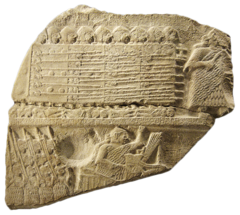Stele of the Vultures

Fragment of the Stele of the Vultures
|
|
| Material | Limestone |
|---|---|
| Size | height: 1.80 metres (5 ft 11 in) width: 1.30 metres (4 ft 3 in) thickness: 0.11 metres (4.3 in) |
| Writing | Sumerian cuneiform |
| Created | Early Dynastic III period (2600–2350 BC) |
| Discovered | Tello, Iraq |
| Present location | Musée du Louvre, Paris |
| Identification | AO 16 IO9, AO 50, AO 2246, AO 2348 |
The Stele of the Vultures is a monument from the Early Dynastic III period (2600–2350 BC) in Mesopotamia celebrating a victory of the city-state of Lagash over its neighbour Umma. It shows various battle and religious scenes and is named after the vultures that can be seen in one of these scenes. The stele was originally carved out of a single slab of limestone but only seven fragments are known today. The fragments were found at Tello (ancient Girsu) in southern Iraq in the late 19th century and are now on display in the Louvre.
The stele is not complete; only seven fragments are known today. The first three fragments were found during excavations in the early 1880s by the French archaeologist Ernest de Sarzec at the archaeological site of Tello, ancient Girsu, in what is today southern Iraq. Another three fragments came to light during the excavations of 1888–1889. A seventh fragment that was later determined to be part of the Stele of the Vultures and thought to have come from Tello was acquired on the antiquities market by the British Museum in 1898. While two initial requests to hand this fragment over to the Louvre were denied by the British Museum, it was eventually given to the Louvre in 1932 so that it could be incorporated in the reconstructed stele together with the other fragments.
The complete monument, as reconstructed and now in display in the Louvre, would have been 1.80 metres (5 ft 11 in) high, 1.30 metres (4 ft 3 in) wide and 0.11 metres (4.3 in) thick and had a rounded top. It was made out of a single slab of limestone with carved reliefs on both sides. The stele can be placed in a tradition of mid- to late-third millennium BC southern Mesopotamia in which military victories are celebrated on stone monuments. A similar monument is the Victory Stele of Naram-Sin, created during the Akkadian period that followed on the Early Dynastic III period.
...
Wikipedia
